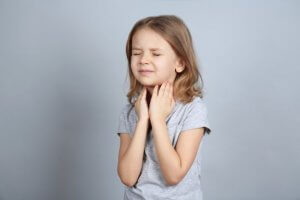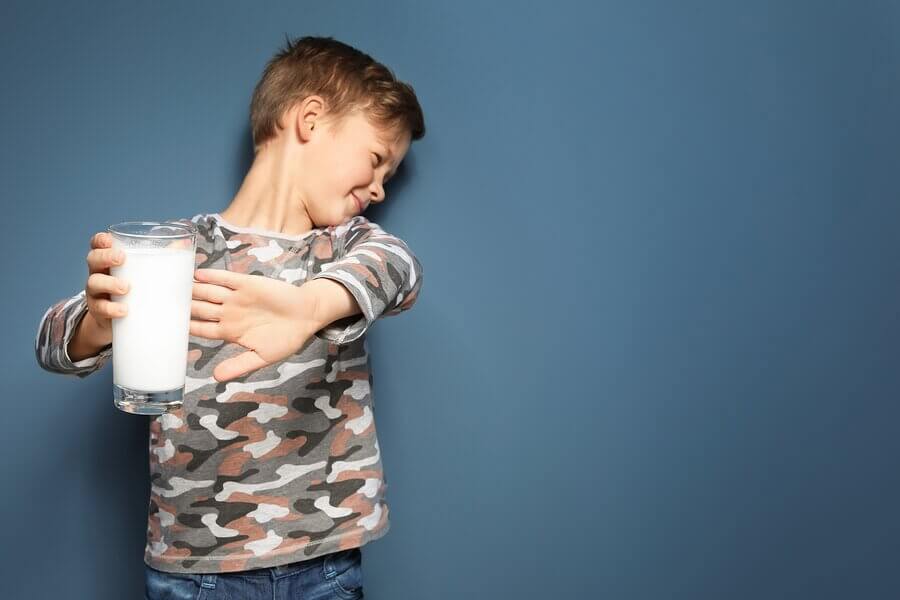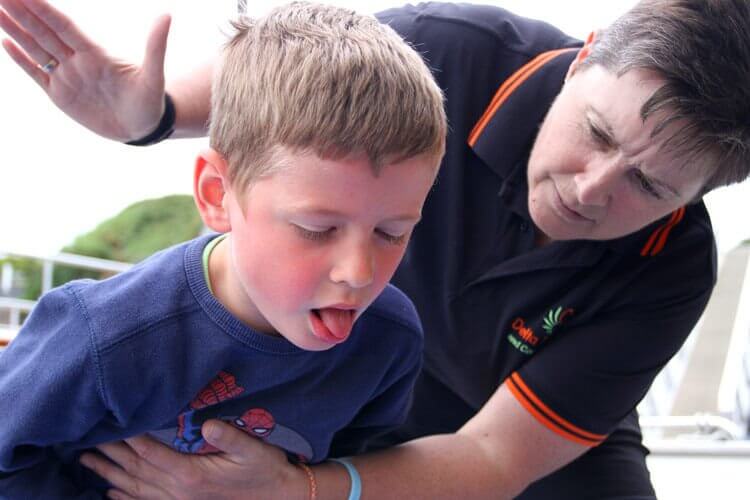Anaphylaxis in Children: Causes, Treatment and Prevention

Anaphylaxis is an allergic reaction that affects several organs. Its causes vary depending on age. It can be difficult to identify anaphylaxis in children, since the symptoms might not be obvious.
In addition, they could be confused with symptoms of other conditions. Since it’s a serious condition, it’s very important that you recognize them quickly.
What is anaphylaxis?
It’s a very dangerous allergic throughout the body, affecting more than two systems of organs at the same time. The term was coined by Charles R. Richet, Nobel Prize in Medicine. It’s also known as anaphylactic shock, allergic reaction, anaphylaxis and anaphylactic reaction.
After being exposed to certain substances, children’s immune systems become sensitive to them. The next time they’re exposed to that allergen, they could suffer from an anaphylactic reaction.
How to identify if your child is suffering from anaphylaxis
Typically, and suddenly, the following symptoms may occur:
- Appearance of hives that are very itchy
- Severe respiratory problems
- Nasal congestion or cough
- Tight throat
- Swollen lips and tongue
- Gastrointestinal disorders such as abdominal pain, cramps, diarrhea, nausea or vomiting
- Temporary loss of consciousness
- Low blood pressure
- Hoarseness or difficulty speaking
- Accelerated heart rate
Potential triggers of anaphylaxis in children
The main triggers of this condition are:
Medicines
Among the medications that can cause an anaphylactic reaction are non-steroidal anti-inflammatory drugs and antibiotics. For example, a common one is amoxicillin. Vaccines and specific immunotherapies rarely cause severe allergic reactions.

Foods
These will vary according to the country and their eating habits, the level of exposure and how the food is prepared. The ones that often cause anaphylaxis in children are eggs, fish, milk, cereals, legumes and nuts.
Other triggers
Among the situations that cause it include a mix of genetic factors and the environment, as well as bites from hymenopteran insects such as wasps, fire ants or bees.
On the other hand, children can suffer from anaphylaxis from exposure to cold, humid or warm environments. In addition, specific situations like menstrual periods and dental work can also cause it.
Idiopathic anaphylaxis
This type of anaphylaxis is one where it’s not possible to identify what agent causes it. This is even after having complete allergy tests. These cases where there isn’t a known cause can affect both children and infants.
4 ways to prevent anaphylaxis in children
You can prevent anaphylaxis in children if you consider these points:
- Avoid triggers that have caused it before. Carefully examine ingredient labels and medication bottles. If you eat out, make sure the restaurant uses ingredients that your child can eat.
- According to what your doctor says, always carry emergency medications with you. It’s also useful to carry equipment for bee stings.
- Add your child’s allergies to their ID or medical identification card.
“The foods that often cause anaphylaxis in children are eggs, fish, milk, cereals, legumes and nuts.”
Immediate treatment
Anaphylaxis can get worse quickly, so it demands immediate treatment. If your child suffers from this type of allergy, always carry an EpiPen with you, also known as adrenaline.
Doctors prescribe self-injectable administration, which looks just like a large pen. This way, it’s easy to apply and it won’t scare your child.
Adrenaline straight to muscles is the most effective way to treat anaphylaxis. This is because it prevents cardiovascular collapse and bronchospasm.

Your pediatrician might suggest that you give your child antihistamines instead of adrenaline. However, these can react when combined with other drugs.
After giving your child the EpiPen when he has a reaction, even if he has calmed down, call 911. Sometimes anaphylaxis has a second wave of symptoms, or biphasic reaction.
At the hospital, they’ll observe your child for about 4 hours or until he’s definitely out of danger. If necessary, they’ll give your child an additional treatment.
Anaphylaxis in children without proper treatment is potentially fatal. Therefore, you need to act immediately. However, don’t obsess over it. Simply learn to act in case your child needs help and continue with your lives like normal.
Anaphylaxis is an allergic reaction that affects several organs. Its causes vary depending on age. It can be difficult to identify anaphylaxis in children, since the symptoms might not be obvious.
In addition, they could be confused with symptoms of other conditions. Since it’s a serious condition, it’s very important that you recognize them quickly.
What is anaphylaxis?
It’s a very dangerous allergic throughout the body, affecting more than two systems of organs at the same time. The term was coined by Charles R. Richet, Nobel Prize in Medicine. It’s also known as anaphylactic shock, allergic reaction, anaphylaxis and anaphylactic reaction.
After being exposed to certain substances, children’s immune systems become sensitive to them. The next time they’re exposed to that allergen, they could suffer from an anaphylactic reaction.
How to identify if your child is suffering from anaphylaxis
Typically, and suddenly, the following symptoms may occur:
- Appearance of hives that are very itchy
- Severe respiratory problems
- Nasal congestion or cough
- Tight throat
- Swollen lips and tongue
- Gastrointestinal disorders such as abdominal pain, cramps, diarrhea, nausea or vomiting
- Temporary loss of consciousness
- Low blood pressure
- Hoarseness or difficulty speaking
- Accelerated heart rate
Potential triggers of anaphylaxis in children
The main triggers of this condition are:
Medicines
Among the medications that can cause an anaphylactic reaction are non-steroidal anti-inflammatory drugs and antibiotics. For example, a common one is amoxicillin. Vaccines and specific immunotherapies rarely cause severe allergic reactions.

Foods
These will vary according to the country and their eating habits, the level of exposure and how the food is prepared. The ones that often cause anaphylaxis in children are eggs, fish, milk, cereals, legumes and nuts.
Other triggers
Among the situations that cause it include a mix of genetic factors and the environment, as well as bites from hymenopteran insects such as wasps, fire ants or bees.
On the other hand, children can suffer from anaphylaxis from exposure to cold, humid or warm environments. In addition, specific situations like menstrual periods and dental work can also cause it.
Idiopathic anaphylaxis
This type of anaphylaxis is one where it’s not possible to identify what agent causes it. This is even after having complete allergy tests. These cases where there isn’t a known cause can affect both children and infants.
4 ways to prevent anaphylaxis in children
You can prevent anaphylaxis in children if you consider these points:
- Avoid triggers that have caused it before. Carefully examine ingredient labels and medication bottles. If you eat out, make sure the restaurant uses ingredients that your child can eat.
- According to what your doctor says, always carry emergency medications with you. It’s also useful to carry equipment for bee stings.
- Add your child’s allergies to their ID or medical identification card.
“The foods that often cause anaphylaxis in children are eggs, fish, milk, cereals, legumes and nuts.”
Immediate treatment
Anaphylaxis can get worse quickly, so it demands immediate treatment. If your child suffers from this type of allergy, always carry an EpiPen with you, also known as adrenaline.
Doctors prescribe self-injectable administration, which looks just like a large pen. This way, it’s easy to apply and it won’t scare your child.
Adrenaline straight to muscles is the most effective way to treat anaphylaxis. This is because it prevents cardiovascular collapse and bronchospasm.

Your pediatrician might suggest that you give your child antihistamines instead of adrenaline. However, these can react when combined with other drugs.
After giving your child the EpiPen when he has a reaction, even if he has calmed down, call 911. Sometimes anaphylaxis has a second wave of symptoms, or biphasic reaction.
At the hospital, they’ll observe your child for about 4 hours or until he’s definitely out of danger. If necessary, they’ll give your child an additional treatment.
Anaphylaxis in children without proper treatment is potentially fatal. Therefore, you need to act immediately. However, don’t obsess over it. Simply learn to act in case your child needs help and continue with your lives like normal.
All cited sources were thoroughly reviewed by our team to ensure their quality, reliability, currency, and validity. The bibliography of this article was considered reliable and of academic or scientific accuracy.
- Cardona, V., Cabañes, N., Chivato, T., De la Hoz, B., Fernández Rivas, M., & Gangoiti Goikoetxea, I. (2016). Guía de actuación en anafilaxia. Galaxia. https://www.aepnaa.org/recursos/publicaciones-archivos/5851f6dd835b9ffc3f32220233dc3eca.pdf
- Magaña, M. J. E., Vargas, M. A., Escalon, J. E., Alcon, A. M., del Río Navarro, B. E., & Sienra Monge, J. J. L. (2007). Anafilaxia y choque anafiláctico. Revista Alergia de Mexico, 54(2). http://scielo.isciii.es/scielo.php?script=sci_arttext&pid=S1137-66272003000400013
- Rubio, C., Lasa, E., Arroabarren, E., Garrido, S., García, B. E., & Tabar, A. I. (2003). Anafilaxia. In Anales del Sistema Sanitario de Navarra (Vol. 26, pp. 103-110). Gobierno de Navarra. Departamento de Salud.
- Zudaire, L. E., de la Lama, M. D. O., & Rodríguez, C. S. (2013). Anafilaxia en pediatría. Protocolos Diagnósticos y Terapéuticos en Pediatría, 1, 63-80. http://www.aeped.es/sites/default/files/documentos/5-anafilaxia.pdf
This text is provided for informational purposes only and does not replace consultation with a professional. If in doubt, consult your specialist.








